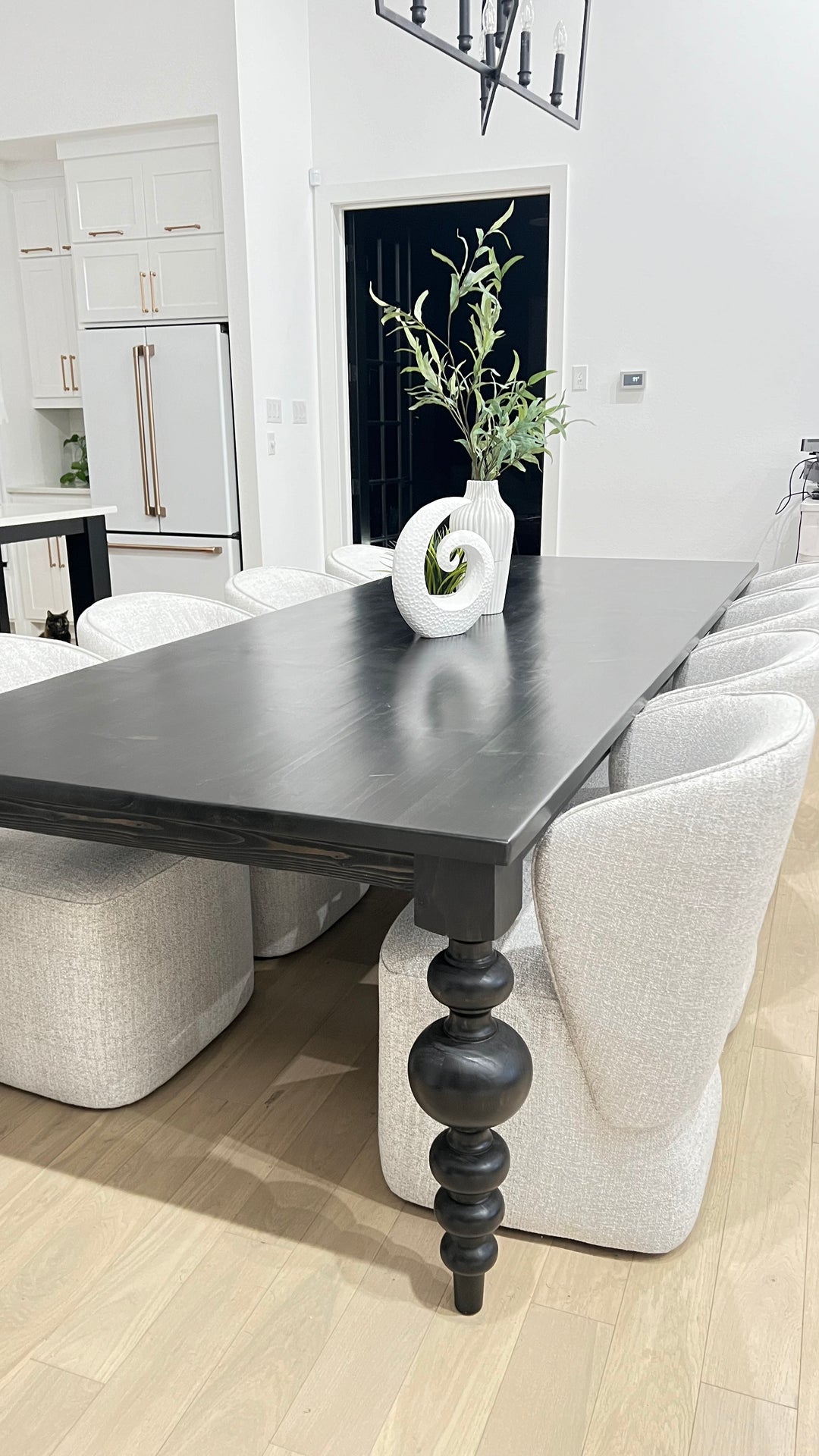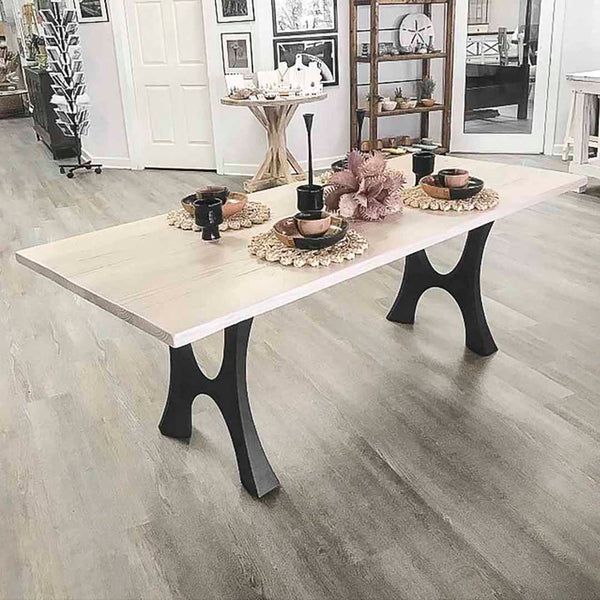From Standard to Modern: Discover the Suitable Dining-room Table Legs for Your Style
While timeless designs such as cabriole and transformed legs evoke a feeling of ageless elegance, contemporary styles like barrette and geometric choices offer a possibility for striking visual interest. As you think about these elements, the inquiry remains: exactly how can you perfectly integrate these varied leg styles to produce a harmonious dining experience?
Comprehending Table Leg Styles
The variety of dining-room table leg styles can dramatically affect both the aesthetics and functionality of the space. Each leg design contributes distinct aesthetic elements and useful attributes, catering to varied design preferences and use needs. Comprehending these designs is vital for picking the appropriate eating table that straightens with your overall indoor style vision.
For example, conical legs use a clean, classic appearance that can improve a space's style, while pedestal bases give stability and make the most of legroom, making them ideal for smaller sized spaces. Hairpin legs, a hallmark of mid-century contemporary design, introduce a commercial panache, enabling an airy, open feel. Similarly, trestle legs stimulate rustic charm, giving robust assistance and a sense of timelessness.
Wooden legs can bring warmth and structure, whereas steel options frequently communicate a streamlined, contemporary vibe. Eventually, comprehending table leg styles is necessary for creating a cohesive dining area that mirrors personal style while ensuring usefulness and comfort.
Traditional Table Leg Options
When picking dining-room table legs, standard choices typically symbolize classic elegance and craftsmanship. These designs show an abundant heritage and a dedication to top quality, making them perfect for those that appreciate traditional appearances.
Among one of the most iconic traditional leg designs is the cabriole leg, defined by its stylish rounded shape. This style often features attractive makings and is most commonly found in Queen Anne and Chippendale furnishings. An additional preferred alternative is the turned leg, which boasts a collection of smooth, rounded shapes that provide a timeless appearance while maintaining security.
Moreover, the straight leg, while basic, uses a basic and durable framework that can blend effortlessly with a range of tabletop designs. For those drawn to ornate detailing, claw-and-ball feet legs stimulate a feeling of splendour and can work as a magnificent centerpiece in any type of dining area.
Last but not least, pedestal bases, although not purely legs, offer an alternate conventional option that enables sufficient legroom and can be wonderfully sculpted. Each of these typical leg designs contributes to the overall atmosphere of a dining space, weding function with aesthetic allure.

Modern Table Leg Layouts
Modern table leg layouts provide a diverse range of styles that emphasize tidy lines and ingenious materials. These layouts usually focus on capability while acting as striking centerpieces within a dining area. Minimalist appearances prevail, with legs crafted from materials such as steel, glass, and engineered wood, which add to a ventilated and contemporary feeling.
One popular style is the barrette leg, characterized by its slender, tapered framework that gives stability without frustrating the tabletop (dining room table legs). This design is typically located in mid-century contemporary furnishings and can easily enhance numerous eating table forms. One more pattern is the usage of geometric shapes, where legs might take on unbalanced or angular kinds, including visual rate of interest and a touch Continue of creativity

Blending Styles for Special Areas
Usually, home owners seek to produce one-of-a-kind eating areas that show their individual style by mixing various layout components. This approach permits the consolidation of diverse appearances, leading to an unified yet distinct environment. For instance, coupling a rustic wooden table with sleek, contemporary metal legs can produce a captivating comparison that elevates the area's overall appeal.
In addition, integrating vintage table legs with contemporary table tops can stimulate a feeling of history while keeping a modern-day perceptiveness. Such mixes not just display individual preference however likewise urge creative thinking, enabling house owners to curate a space that really feels both individual and welcoming.
Shade plays an essential duty in this blending process; selecting table legs that match or contrast with the existing color design can boost visual passion. For instance, whitewashed legs can soften the daring of a dark table surface, creating a balanced aesthetic.
Tips for Selecting the Right Legs
Picking the right table legs is vital for achieving both performance and aesthetic allure in your dining room. Begin by thinking about the overall style of your room. Conventional settings take advantage of legs that feature detailed carvings or transformed styles, while modern areas might ask for sleek, minimalist styles.
Following, assess the height and security of the legs. dining room table legs. Common table vary between 28 to 30 inches in height, so guarantee the legs match this dimension for convenience. In addition, check my blog durable products, such as wood or steel, can boost stability and longevity
Evaluate the leg shape as well-- alternatives include right, tapered, or pedestal designs. Straight legs supply a classic appearance, while conical legs can add a touch of style. Pedestal bases give sufficient legroom and are optimal for smaller rooms.
Verdict
In recap, picking the suitable dining-room table legs needs cautious factor to consider of both traditional and modern-day designs. Typical options such as cabriole and turned legs provide classic beauty, while modern layouts like hairpin and geometric forms provide a modern touch. By balancing leg design, elevation, great post to read and material with the overall décor, a cohesive and inviting ambience can be accomplished. Inevitably, the selected table legs should mirror the desired aesthetic, improving the eating experience within the area.
The range of dining area table leg styles can considerably affect both the aesthetic appeals and performance of the room. Inevitably, comprehending table leg styles is important for developing a cohesive dining area that mirrors individual design while ensuring usefulness and convenience.One of the most legendary standard leg designs is the cabriole leg, characterized by its stylish bent form. Straight legs use a timeless appearance, while tapered legs can include a touch of beauty.In recap, selecting the perfect eating area table legs needs mindful factor to consider of both contemporary and typical designs.